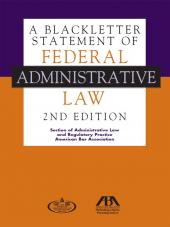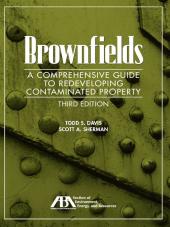Implementing Institutional Controls at Brownfields and Other Contaminated Sites
Select a format
 International Order Inquiry
International Order Inquiry
Select subscription type
Terms & conditions
Subscribers receive the product(s) listed on the Order Form and any Updates made available during the annual subscription period. Shipping and handling fees are not included in the annual price.
Subscribers are advised of the number of Updates that were made to the particular publication the prior year. The number of Updates may vary due to developments in the law and other publishing issues, but subscribers may use this as a rough estimate of future shipments. Subscribers may call Customer Support at 800-833-9844 for additional information.
Subscribers may cancel this subscription by: calling Customer Support at 800-833-9844; emailing customer.support@lexisnexis.com; or returning the invoice marked "CANCEL".
If subscribers cancel within 30 days after the product is ordered or received and return the product at their expense, then they will receive a full credit of the price for the annual subscription.
If subscribers cancel between 31 and 60 days after the invoice date and return the product at their expense, then they will receive a 5/6th credit of the price for the annual subscription. No credit will be given for cancellations more than 60 days after the invoice date. To receive any credit, subscriber must return all product(s) shipped during the year at their expense within the applicable cancellation period listed above.
The total price includes the product(s) listed in the Order Form and any Updates for a limited period (minimum period of 30 days) after the order is placed ("Order Window"). Shipping and handling fees are not included in the grand total price.
All shipments may be returned, at subscribers' expense, for full credit of the Price within 30 days of receipt.
Shipments may not be returned, and no credits will be issued, more than 30 days after receipt.
After the Order Window, subscribers will receive notice of Updates along with the then-current grand total price and order process as Updates become available. Subscribers will only be shipped those Updates they specifically request.
Product description
View a sample of this title using the ReadNow feature
Institutional controls are designed to reduce or eliminate potential exposure to certain chemicals, prevent activities that may interfere with a response action, and to ensure that "no significant risk" is posed to human health and the environment. Institutional controls take a wide variety of forms, such as easements, restrictive covenants, equitable servitudes, environmental covenants, zoning, building permits, well-drilling prohibitions, contractual agreements (such as permits and consent decrees), and informational devices.
This second edition of Implementing Institutional Controls at Brownfields and Other Contaminated Sites examines the substantial strides that have been made over the past decade to improve regulators' and practitioners' awareness and understanding of institutional control issues. In particular, nearly half the states have now adopted the Uniform Environmental Covenants Act (UECA) since its promulgation as a model state law in 2003.
Now fully updated and significantly expanded, Implementing Institutional Controls at Brownfields and Other Contaminated Sites discusses why UECA is important and how most states are handling institutional control issues, whether they have adopted UECA or not. Other institutional control tools, such as EPA's use of five-year reviews under the federal Superfund law, Land Use Control Implementation Plans, and state and local innovations (such as municipal setting designations in Texas), are also discussed.
In addition to the text, extensive supporting materials are included on a CD-ROM that accompanies this volume.
eBooks, CDs, downloadable content, and software purchases are noncancelable, nonrefundable and nonreturnable. Click here for more information about LexisNexis eBooks. The eBook versions of this title may feature links to Lexis+® for further legal research options. A valid subscription to Lexis+® is required to access this content.
Table of contents
Part I: Overview and Emerging Tools
Chapter 1 An Overview of Institutional Controls
Chapter 2 CERCLA "Five-Year Reviews" as a Long-Term Institutional Control Assurance Tool
Chapter 3 The Benefits of a Uniform State Law for Institutional Controls
Chapter 4 Identifying Activity and Use Limitations as Part of All Appropriate Inquiries in the Due Diligence Process
Chapter 5 Institutional Controls as a Risk Management Option
Chapter 6 Activity and Use Limitations Applied to Risk-Based Corrective Action
Chapter 7 Remedy Selection at Closing Military Bases: Institutional Controls
Chapter 8 Long-Term Environmental Management at Contaminated School Sites with an Emphasis on Vapor Intrusion
Chapter 9 Institutional Controls and Insurance
Chapter 10 Land Use Restrictions and Institutional Controls under the Brownfields Amendments of 2002
Chapter 11 Life Cycle Costs of Institutional Controls
Part II: Case Studies
Chapter 12 Land Use Control Implementation Plans: A Model
Chapter 13 Information Technology for Institutional Control Management of Environmentally Impaired Properties
Chapter 14 Mississippi "One Call" and the Mississippi Uniform Environmental Covenants Act
Chapter 15 Texas Municipal Setting Designations
Chapter 16 Lessons Learned in Tracking Institutional Controls in Emeryville, California
Chapter 17 Rochester, New York: A Local Government–Initiated Environmental Institutional Control Program
Part III: Selected States and Ontario, Canada
Chapter 18 Alabama
Chapter 19 Arizona
Chapter 20 Arkansas
Chapter 21 California
Chapter 22 Colorado
Chapter 23 Connecticut
Chapter 24 Florida
Chapter 25 Georgia
Chapter 26 Hawai'i
Chapter 27 Illinois
Chapter 28 Indiana
Chapter 29 Iowa
Chapter 30 Kansas
Chapter 31 Kentucky
Chapter 32 Louisiana
Chapter 33 Maine
Chapter 34 Maryland
Chapter 35 Massachusetts
Chapter 36 Massachusetts
Chapter 37 Michigan
Chapter 38 Minnesota
Chapter 39 Mississippi
Chapter 40 Missouri
Chapter 41 Montana
Chapter 42 Nebraska
Chapter 43 Nevada
Chapter 44 New Hampshire
Chapter 45 New Jersey
Chapter 46 New Mexico
Chapter 47 New York
Chapter 48 North Carolina
Chapter 49 Institutional Controls in Ohio: A Brownfield Developer's Perspective
Chapter 50 Institutional Controls in Ohio: A Private Practitioner's Perspective
Chapter 51 Oklahoma
Chapter 52 Oregon
Chapter 53 Engineering and Institutional Controls in Pennsylvania: A Public Sector Perspective
Chapter 54 Pennsylvania: A Private Practitioner's Perspective
Chapter 55 Rhode Island
Chapter 56 South Carolina
Chapter 57 Tennessee
Chapter 58 Texas
Chapter 59 Utah
Chapter 60 Vermont
Chapter 61 Virginia
Chapter 62 Washington State
Chapter 63 West Virginia
Chapter 64 Wisconsin
Chapter 65 Ontario, Canada
Conclusion
Institutional Controls and the Converging Worlds of Real Estate and Environmental Law
 Lexis Nexis
Lexis Nexis 
